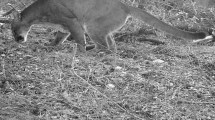Abstract
The frequency and pattern of distribution of scent-mound construction were studied in a population of beaver in southeast Ohio from 1975 through 1977. The study addressed the questions of whether or not the frequency of scent-mound construction varied with season, site, year, and degree of contact with other family groups, and whether the pattern of scent-mounding activity was parsimonious with the idea of “territorial marking.” The number of scent-mounds constructed was determined weekly for each site throughout the ice-free season. Scent-mounding activity was highest in spring and declined and remained low during summer and fall. Significant differences were found amoung sites and over years. Contact with other resident family groups altered both frequency and pattern of scent-mound construction. Scent-mounds did not conform to a “scent-fence” model. The most parsimonious interpretation of function of odor cues deposited on scent-mounds is the effect on the motivational state of residents and nonresidents, increasing the confidence and reducing anxiety in residents smelling their own scent-mound and decreasing the confidence and increasing the readiness to flee in trespassers encountering a strange scent-mound.
Similar content being viewed by others
References
Aleksiuk, M. 1968. Scent-mound communication, territoriality and population regulation in beaver (Castor canadensis Kuhl).J. Mammal. 49:759–762.
Beer, J.R. 1955. Movements of tagged beaver.J. Mammal 19:492–493.
Dixon, W. (ed.). 1974. Biomedical Computer Programs. University of California Press, Los Angeles, California, 773 pp.
DoboszyŃska, T., andZurowski, W. 1975. Changes observed in the reproductive tract of a beaver female after high dosages of gonadotropic hormones.Acta Theriol. 20:105–112.
Eisenberg, J.F., andKleiman, D.G. 1972. Olfactory communication in mammals.Annu. Rev. Ecol. Syst. 3:1–32.
Ewer, R.F. 1968. Ethology of Mammals. Plenum Press, New York, 418 pp.
Hediger, H. 1949. Säugetierterritorien und ihre Markierung.Bijdr. Dierkde 28:172–184.
Kleiman, D. 1966. Scent-marking in the Canidae.Symp. Zool. Soc. London 18:167–177.
Krames, L., Carr, W., andBergman, B. 1969. A pheromone associated with social dominance among male rats.Psychonom. Sci. 16:11–12.
Lederer, E. 1949. Chemistry and biochemistry of some mammalian secretions and excretions.J. Chem. Soc. (London) 2115–2119.
Lederer, E. 1950. Odeurs et parfums des animaux.Fortshr. Chem. Org. Naturst. 6:87–153.
Mech, L.D., andPeters, R.P. 1977. The study of chemical communication in free-ranging mammals, pp. 321–332,in D. Müller-Schwarze and M.M. Mozell (eds.), Chemical Signals in Vertebrates. Plenum Press, N.Y., 609 pp.
Müller-Schwarze, D. 1971. Pheromones in black-tailed deer (Odocoileus hemionus columbianus).Anim. Behav. 19:141–152.
Mykytowycz, R., Hesterman, E., Gambale, S., andDudzinski, M. 1976. A comparison of the effectiveness of the odors of rabbits,Oryctolagus cuniculm, in enhancing territorial confidence.J. Chem. Ecol. 2:13–24.
Nei, N., Hull, C., Jenkins, J., Steinbrenner, K., andBent, D. 1970. Statistical Package for the Social Sciences. McGraw-Hill, New York, 675 pp.
Peters, R., andMech, L.D. 1975. Scent-marking in wolves.Am. Sci. 63:628–637.
Provost, E. 1958. Studies on reproduction and population dynamics in beaver. Unpubl. PhD dissertation, Washington State University, Spokane, 788 pp.
Ralls, K. 1971. Mammalian scent marking.Science 171:443–449.
Sokal, R.R., andRohlf, R.J. 1969. Biometry. W.H. Freeman and Company, San Francisco, 776 pp.
Svendsen, G.E. 1978. Castor and anal glands of the beaver (Castor canadensis).J. Mammal. 619–620.
Svendsen, G.E. 1979a. Territoriality and behavior in a population of pikas (Ochotona princeps).J. Mammal. 60:324–330.
Svendsen, G.E. 1979b. Seasonal change in feeding patterns of beaver (Castor canadensis) in southeast Ohio.J. Wildl. Manage. Submitted.
Taylor, D. 1970. Growth, decline, and equilibrium in a beaver population at Sagehen Creek, California. Unpubl. PhD dissertation, University of California, Berkeley, 162 pp.
Theissen, D. 1972. Footholds for survival.Am. Sci. 61:346–351.
Theissen, D., andRice, M. 1976. Mammalian scent gland marking and social behavior.Psychol. Bull. 83:505–539.
Valenta, J., andRigby, M. 1968. Discrimination of odor of stressed rats.Science 161:599–601.
Valenta, Z., andKhaleque, A. 1959. The structure of castoramine. Tetrahedron Lett. 12:1–5.
Valenta, Z., Khaleque, A., andRashid, M.H. 1961.cis-Cyclohexane-1,2 diol in the beaver gland.Experientia 17:130.
Wilsson, L. 1971. Observations and experiments on the ethology of the European beaver (Castor fiber L.).Viltrevy 8: 116–261.
Author information
Authors and Affiliations
Rights and permissions
About this article
Cite this article
Svendsen, G.E. Patterns of scent-mounding in a population of beaver (Castor canadensis). J Chem Ecol 6, 133–148 (1980). https://doi.org/10.1007/BF00987533
Received:
Revised:
Issue Date:
DOI: https://doi.org/10.1007/BF00987533




